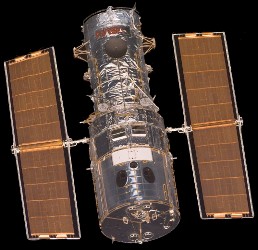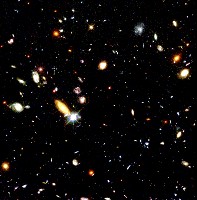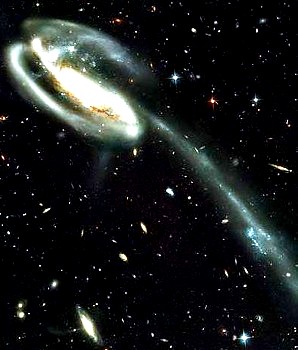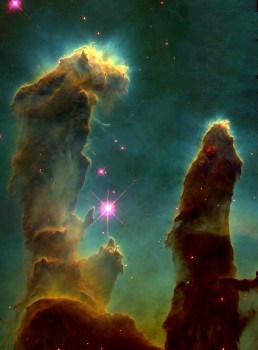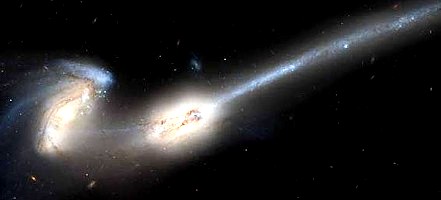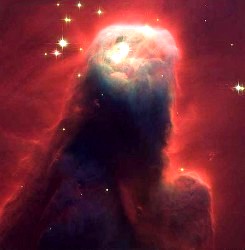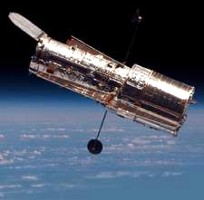 As of March 2000, Hubble had:
As of March 2000, Hubble had:
- Made over 330,000 observations of more than 25,000 astronomical objects. - Generated 7.3 terabytes of data (enough to fill your computer every day for 10 years). - Provided data for more than 2,663 scientific papers. - Travelled about 2.4 billion kilometres - nearly the distance from Earth to Uranus. - Received about 93 hours of upgrades in 3 successful Shuttle servicing missions. Hubble is completely controlled by scientists on the ground. Four antennae send and receive information between the telescope and the Flight Operations Team at the Space Telescope Science Institute, via the Tracking and Data Relay Satellite system; there are currently five TDRS satellites located at various locations in the sky. 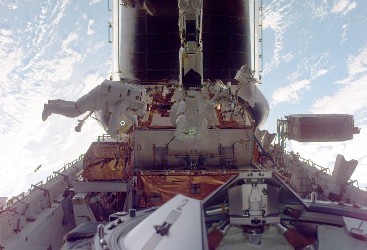
Every few years, a team of astronauts carried a selection of new equipment on the Space Shuttle designed to upgrade the Hubble telescope. This included improved instrumentation or electronics, new optical devices, or special instrument packages. At the right, you can see astronauts servicing the telescope, which has been docked inside the shuttle bay. The telescope is manoeuvered into place using the 'Canadarm' robotic arm, by an astronaut inside the shuttle. As you can see, the shuttle was flying 'upside down', with Earth appearing to hang above them in the sky as they work. Shown below are two images showing the release of the Hubble telescope back into its own orbit, also accomplished using the Canadarm. 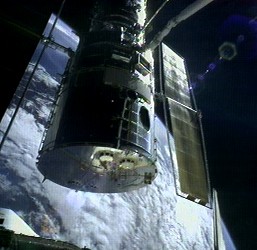 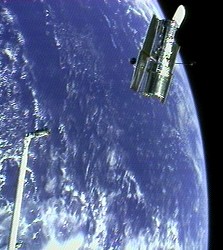 Hubble needs electricity to operate. This is obtained using two wing-like solar arrays, each covered by solar cells that convert the sun's energy into 3,000 watts of electricity, to run the telescope's scientific instruments, computers, and radio transmitters. The solar arrays are designed for replacement by astronauts, when necessary. They can be rolled up or folded for shuttle trips to and from Hubble. Some of the electricity generated is stored in batteries so that the telescope can operate while it's in Earth's shadow (about 36 minutes out of each 97 minute orbit). Fully charged, each battery contains enough energy to operate the telescope for 7.5 hours. As the Hubble telescope passes in and out of direct sunlight, it has to endure dramatic temperature extremes ... fluctuations of more than 100° Fahrenheit. To help protect the telescope, a blanket of multilayered insulation covers the aluminum shell housing the instruments. The telescope itself is held together by a truss made of graphite epoxy that is stiff, strong, and light, and that resists expanding and contracting. The telescope uses a Cassegrain-type arrangement of mirrors, which have been polished very smooth ... if Hubble's primary mirror were scaled up to the diameter of the Earth, the biggest bump would be only 15 cm tall. Shortly after Hubble's original debut in 1990, scientists found that the primary mirror's shape was incorrect, causing 'spherical aberration'. Fortunately, corrective lenses were able to solve this problem. The mirrors are kept at a nearly constant room temperature (about 21° C) to avoid warping. 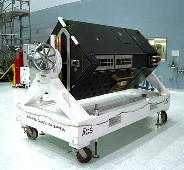 In March 2002, shuttle astronauts installed in the telescope a new 'Advanced Camera for Surveys', which increased Hubble’s ability to spot distant objects by a factor of ten. The ACS unit produces pictures in high resolution; at 16 million pixels per image, the pictures produced by this new instrument package are stunning.
In March 2002, shuttle astronauts installed in the telescope a new 'Advanced Camera for Surveys', which increased Hubble’s ability to spot distant objects by a factor of ten. The ACS unit produces pictures in high resolution; at 16 million pixels per image, the pictures produced by this new instrument package are stunning.NASA has released images taken by the new instruments, which we have included below. We should point out that the colours visible in the photos are not necessarily those you would see with your eyes alone; sometimes colours are added to make different parts of the object stand out more clearly.
|
